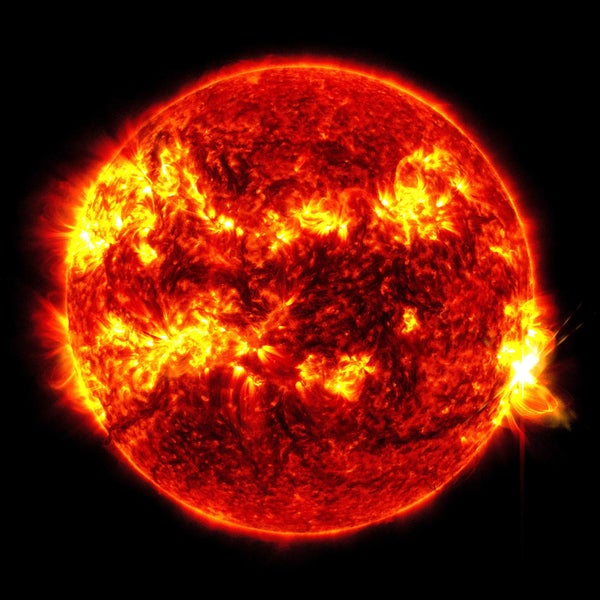A massive group of sunspots has produced the largest flare of the current solar cycle—but the stunning auroral spectacles that Earth enjoyed in recent days are unlikely to resume, experts say.
The sunspot cluster, known as active region 3664 (AR3664), broke a record on Tuesday when it emitted the largest flare to date of our sun’s current activity cycle. This X8.7-class flare peaked at 12:51 P.M. EDT, according to the National Oceanic and Atmospheric Administration’s Space Weather Prediction Center, which monitors the sun’s activity and its potential impacts on Earth.
A sunspot is a magnetic knot on the sun in which cooler temperatures make that part of the star’s surface appear darker than surrounding areas. These structures often produce solar flares—essentially huge flashes of high-energy light that, if pointed at Earth, can reach our planet in about eight minutes, sometimes trailed by slower-moving energetic particles that are also ejected by the blasts. Sunspots can also spark coronal mass ejections (CMEs), which are enormous clouds of charged plasma that can strike our planet within days of erupting from the sun.
On supporting science journalism
If you're enjoying this article, consider supporting our award-winning journalism by subscribing. By purchasing a subscription you are helping to ensure the future of impactful stories about the discoveries and ideas shaping our world today.
At one point, this particular sunspot region stretched some 16 times the width of Earth. The size drew comparisons to the active region that produced the infamous 1859 Carrington Event, a massive solar storm that interrupted telegraph service worldwide and lit up our planet’s skies with auroral displays. A similar solar storm today could damage vital infrastructure such as power grids, communications systems and GPS navigation satellites. The impacts of AR3664 have been generally benign, however, despite the dramatic outbursts.
Beginning on May 7, AR3664 shot out a spree of half a dozen CMEs that started to reach Earth just after 12:30 P.M. EDT on May 10 and produced stunning auroras that night. The auroras occurred in both hemispheres and stretched as far from our planet’s poles as Puerto Rico and Mexico. The spectacle came with minimal downsides, although airplane flights were rerouted to avoid higher radiation levels near the poles, high-frequency radio systems experienced interference, and farmers who used precision GPS to steer tractors reported glitches as well.
Then came today’s massive flare, which was the third X-class flare produced by the sunspot cluster in less than 24 hours. The flare may disrupt high-frequency radio communications on the sunlit side of Earth but is not expected to cause major issues for humans.
CMEs sometimes follow flares, but scientists aren’t sure yet whether today’s large flare will be accompanied by a CME. Even if it is, additional auroras are unlikely because Earth is now out of range of such an outburst from this sunspot region.
That’s because like everything else in space, the sun rotates, with any given spot on its surface taking about a month to complete a circuit around the star. AR3664 is currently just out of direct view, having slipped past the edge of the solar disk as we see it from Earth. Scientists say there’s a chance this active region may be able to retain its structure as it traverses the far side of the sun, however, and potentially rotate back into view about two weeks from now.
The sun’s activity over the past week has been notable but not unexpected, given that the sun is near the peak of its activity cycle, which lasts about 11 years and reflects the way the star’s magnetic field warps and tangles and then unknots itself.
